Submachine thought process
March 22, 2022
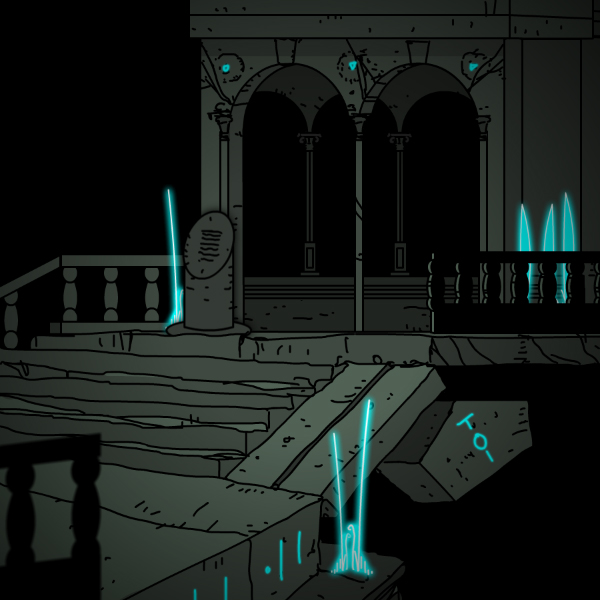
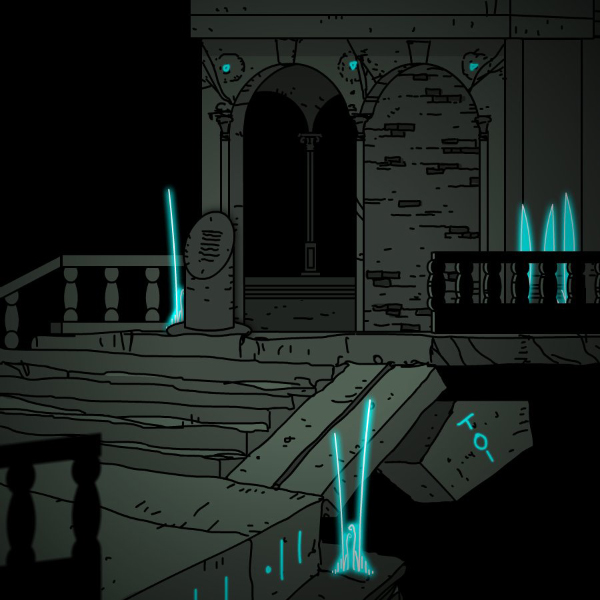
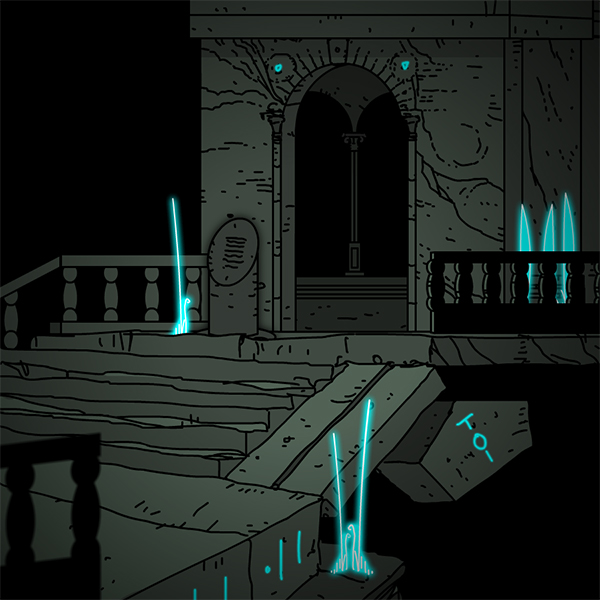
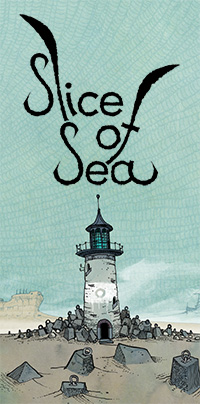 I’ve spent eight hours with Slice of Sea, drinking in its otherworldly landscapes, mingling with its bizarre inhabitants, carefully digging through its environments to figure out my next steps, and I still feel basically helpless to tell you about it. It’s such a singular experience that there’s hardly a basis for comparison. How to explain that this dialogue-free journey through a watercolor dreamscape—the staggeringly complex work of solo developer Mateusz Skutnik—is one of the best adventures of the year? The only way to do it justice, I fear, would be to take your hand and walk you through scene by scene, pointing at all the little things that make it work and periodically looking over to go “See? See?!” Absent that possibility, I hope you’ll take my word for it: this is a one-of-a-kind excursion into a strange and fascinating world like you won’t find anywhere else, and even with a few caveats it isn’t to be missed.
I’ve spent eight hours with Slice of Sea, drinking in its otherworldly landscapes, mingling with its bizarre inhabitants, carefully digging through its environments to figure out my next steps, and I still feel basically helpless to tell you about it. It’s such a singular experience that there’s hardly a basis for comparison. How to explain that this dialogue-free journey through a watercolor dreamscape—the staggeringly complex work of solo developer Mateusz Skutnik—is one of the best adventures of the year? The only way to do it justice, I fear, would be to take your hand and walk you through scene by scene, pointing at all the little things that make it work and periodically looking over to go “See? See?!” Absent that possibility, I hope you’ll take my word for it: this is a one-of-a-kind excursion into a strange and fascinating world like you won’t find anywhere else, and even with a few caveats it isn’t to be missed.
You’re a sea creature in a mechanical suit that lets you walk on land, and you’re wandering through a vast, sandy region full of decaying train cars and dormant machinery in an effort to get … somewhere. That’s all the setup the game provides you, and you’ll get no more context for it until the very end. Promotional materials name our protagonist Seaweed, but even that information is superfluous to the experience; you are who you are, you’re where you are, and there are things to do around you. The game trusts you to figure out the rest.
You control Seaweed using a simple keyboard/mouse setup, with the arrow keys or A and D moving you left and right along the horizontal plane, the up/W key (or spacebar) dedicated to jumping and the down/S key letting you enter doorways and passages. Your mouse cursor is shaped like a fancy pen nib, shifting to an open hand when you hover over a hotspot. Occasionally a particularly inscrutable hotspot will come with a caption to explain what it is, but more often than not the cursor change is all the indication you’ll get. Right-clicking opens your inventory, from which you can drag objects to use in the environment. Interestingly, Seaweed doesn’t have to be physically near or even able to access a hotspot for you to interact with it via the mouse; if you, the player, can see it on screen, you can click it or use an object. This means that, movement aside, you’ll sometimes feel less like you’re playing as Seaweed than as an omniscient observer helping them out on their journey.
Seaweed’s world is big, open and lonely, and each screen gives the impression of a once-bustling world whose gears have long since come creaking to a halt. Everywhere are crumbling mechanisms and stilled engines; beached ships, derailed train cars and busted machinery dot the landscape, long-abandoned by whoever it was that once maintained them. Sand is everywhere, gumming up the works and slowly obscuring the borders between civilization and wilderness. People live here—or creatures that resemble people—but most of these are wanderers too; those few who appear at home where you find them seem nonetheless suspicious and anxious. Something happened here, and the game never comes close to explaining what it was; still, the more you explore the more you’ll find yourself feeling that you’ve almost grasped it.
The environments have the style and character of a forgotten picture book. The thick lines and exaggerated dimensions of the backgrounds are reminiscent of Gahan Wilson, while the bizarre characters with their feathery brushstrokes and impressionistic watercolor features might have been lifted from Quentin Blake’s nightmare journal. Every space, no matter how apparently deserted, feels alive—like you’re simply passing through somewhere that once played host to other stories and will continue existing long after you’ve left. The sublimely haunting score by The Thumpmonks hangs over everything, seeming to embody and express both the barrenness of the dunes and Seaweed’s own loneliness. Synth tones like whistling sea breezes mingle with forlorn chimes and keening train whistles, while certain tracks call to mind a forgotten Victrola record, with croaking horns backed by whispering percussion like distant rain. (That’s to say nothing of “Let Me Go Home,” the superb end-credits song by Cat Jahnke.) Unsurprisingly, the soundscape is equally superb, bringing the vast locales to creaking, windblown life as you pass through.
Huge and lonely it may be, but the setting is anything but empty. A varied menagerie of strange beings lurk in the rubble and tumbledown settlements; some are hominid, like the sad-looking goblin people who pace aimlessly and avoid acknowledging you, while others seem more animalistic, like the scuttling hairballs who peer out at you from the shadows. Still others are totally alien, like the winged, spidery beast who leers at you with a human face. The character designs are all inventive and unexpected, and the total absence of context or explanation adds a depth and breadth to the place that lengthy expostulation couldn’t. Seaweed may or may not know why, for example, giant whispering nautiluses float watchfully overhead in so many places, but either way it requires no comment—that’s how this world works, and it’s beyond any one person (or wide-eyed sea creature) to explain.
Every screen is loaded with details whose functions you puzzle out by clicking. The game is 100% dialogue-free, with the only legible text appearing when you hover over items in your inventory and certain (but not most) hotspots. On those few occasions where you receive instruction, it comes in the form of pictographic diagrams. As much as it expects you to learn by doing, though, the game is very rarely inscrutable; on occasions when I gave up and consulted a walkthrough to figure out what exactly I had to do next, it almost always turned out to be because I’d overlooked a detail that was hiding quite prominently in plain sight. This wasn’t always the case—a few necessary objects struck me as having been hidden much too well—but if you take your time and really give your surroundings a good once-over, the puzzles turn out to be quite intuitive.
Many of these are inventory-based; Seaweed has an unlimited capacity for item storage and the environments are littered with objects to collect, so at times part of the challenge comes from sorting through your hoard to figure out what, if anything, is relevant. Much of what you can pick up turns out to be useless detritus or shiny, optional collectibles, but soon enough you’ll begin to get a sense for what’s important and what isn’t. Oftentimes an object’s name will clue you in to where you should use it: you might not realize, for instance, that a particular background structure is pertinent until you find something whose name evokes it. It’s immensely satisfying to piece various clues together and then to suddenly understand the context that unites disparate elements, or to realize that some visual detail you’ve passed a hundred times is the key to progressing further.
Many obstacles require figuring out how to operate arcane machinery; as with the other puzzles, you’ll have to experiment. Some machine parts only activate if Seaweed is physically near them; others have multiple moving components that you’ll need to work all at once. Still others have complex and untraditional locks that will only open once you’ve entered their combinations. These can involve noting down symbols you observe around the game world, collecting certain items to place in an incomplete display, or occasionally manipulating visual arrays into configurations you’ve discovered elsewhere. As with the inventory puzzles, divining the solutions means paying attention to your surroundings and being observant on every screen; as long as you keep thinking about what you see, you’ll find the game has given you what you need to move forward.
And how much moving you’ll do! Slice of Sea’s world is enormous, with a staggering number of distinct screens to explore, and you’ll traverse every inch of it several times over. It’s good, then, that Skutnik minimizes what could have been a daunting inconvenience by giving Seaweed a brisk walking speed and providing an incredibly helpful teleportation system. There are fifteen waypoints scattered around the landscape, each of which has to be brought on-line with a click. Once you’ve found one, you can use it to immediately travel to any of the others you’ve previously located. They’re distributed in such a way that, while you’ll still have to do some trekking, manual travel is so greatly reduced as to become hardly noticeable after a while. There’s even an item you can find that lets you teleport to any waypoint no matter where you are, making a user-friendly process even easier.
Unfortunately, not all travel is this straightforward. As mentioned, this is a game where—apart from some early on-screen prompts to explain the controls—you’ll have to figure out how things work on your own. One rule that’s never explained, however, is that places where you can travel “north” (i.e., go through an open doorway, gate, or passage in the middle of the screen) are marked by waving banners bearing a cryptic rune. Sometimes the exit is so obvious that the extra signage isn’t necessary, but in other places there’s nothing to indicate that there even is an exit. More than once I wandered back and forth, at a total loss for what to do next, only to finally look up where to go and realize that a seemingly noninteractive vista was a pathway to whole new swathes of the world. This happened several times before I belatedly noticed the flags fluttering over each of the exits I’d missed and realized what they signified.
Thankfully this is an ultimately minor issue in a game that otherwise does a fantastic job of drawing you in and beckoning you further into its world. Even after saying all this, I’ve only managed to scratch the surface of what makes Slice of Sea so special; words are ill-suited to describe something that seems in some ways to exist beyond them. Such abstract storytelling won’t be to every player’s taste, of course, and the lack of direction may be a difficult sell for some. Still, the exploration and puzzle-solving are so engaging, and the world so vividly realized, that anyone who gives it the chance it deserves will find an uncanny experience like few others out there, and one that will stick with them for a long time.
Our Verdict:
Slice of Sea sets you loose in a gorgeously illustrated dreamscape and trusts you to figure out what needs doing along the way. Its lack of direction won’t be to everyone’s taste, but if you long to get lost in beautiful otherworldly surroundings, you won’t want to miss it.
4.5/5
The Good:
– Stunningly beautiful hand-drawn art with unique character designs, wonderfully strange creatures, and evocative sound design
– A huge world to explore with lots to do
– Beautiful, haunting score with an excellent end-credits song
– Puzzles are well-designed and rewarding to figure out
– Teleportation system makes traveling easy while still preserving the vastness of the world
The Bad:
– Some important visual elements are easy to miss, especially screen exits
– Incredibly abstract and un-straightforward in a way that may turn some players off
written by Will Aickman — 24 Jan 2022
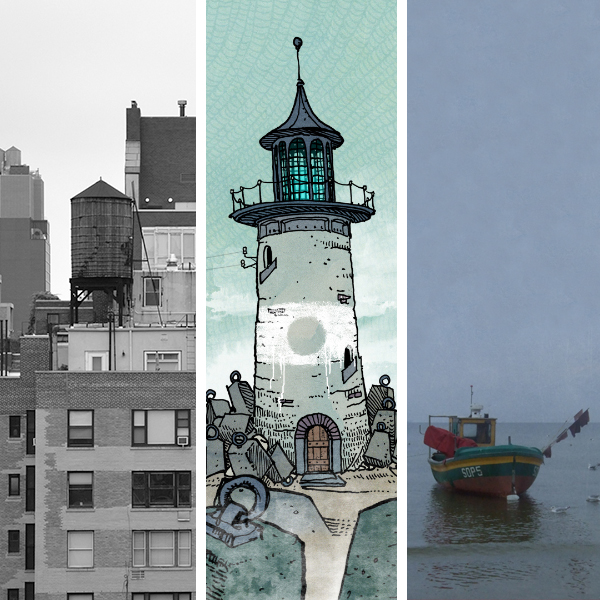
The year of ending things. Here we go.
Plan A
Can you guess? Finishing and releasing Slice of Sea.
I feel I can write a very long article about the whole development process, but it’s too early for that. So, for now: yes, it was finished, yes, it was released, yes, I made my debut on Steam. I managed to finally push through Apple macOS trenches and create notarized app for this game, which in turn let me publish macOS version. All of this was kind of new to me, even after almost 20 years in the business. I mean – releasing the game on Steam. Creating proper game trailers, optimizing Steam store page, hitting that button that says “release the game”… Now I know so much more about the process and releasing more games on Steam won’t be as painful and draining as that first one. On a side note – I don’t intend to get swamped in a 4-year-long project ever again. Done it once, that’s enough for me, thank you very much. I played the game few days ago, about two months after publishing – and I still like the design. This is a good sign. I played it, because I finally caved in and added more door tutorials throughout the game in places where people got stuck and missed crucial locations because background passage indication wasn’t clear enough. There have always been hints that symbolized those passages in the game, but clearly not enough. Now they’re in your face, you can’t miss it. If you want to see where I added them, update the game on Steam to the latest version (v1.0.14). If you feel it’s too much hand holding – please don’t blame me. This latest, 14th update kind of rounds up the post-release bug-fixing phase. Game is done. Hallelujah.
Plan B
The last entry in the 10 Gnomes series. The project of 12 years is finishing this year. And it’s going out with a bang, since the final gnomes take place in New York. I could write a long and sappy story about gnomes starting back in 2008 in my home town and finishing in New York of all places, but I think I’ll save that for a proper post-mortem article about gnomes once it’s done and shipped. Also – Where is 2022? Yeah, sure, at this point, why not? I’m sure Santa is up for that as well.
What was surprising to me, was that it was a surprise to so many 10 Gnomes players. The fixed ending to this series was known to the public for at least 10 years. This was a project 12 games spanning over 12 years. Still, people were caught off-guard when the series finished with it’s last installment set in New York. Just as I perfected the gnomes formula, the series ended. I got lots of comments that this flow of the game, so different from all previous in the series – was the best. So, nothing left but to close the series and go out on top.
Now, the last “Where is… ?” game is a bit different story. Let me explain. After finishing the gnomes series – “Where is…?” was the last remnant of the flash era. By that I mean – a series of recurring small games that were meant to be published periodically. But now we’re in a different era. Flash is dead and flash-like thinking about what a game series is – should die too. Also this was the last project with a set deadline for each game. I hate deadlines and got rid of them years ago. This was the last one. It felt right, to retire Santa. I also managed to tie this ending to the gnomes series, in this last Santa game you visit all 24 locations of all gnomes games. And the flow is the same as in that last gnomes game. They were going strong hand in hand throughout all those years, now they both went out in style also hand in hand. Like Bonnie and Clyde. Like Thelma and Louise.
Plan C
Submachine Card Game Kickstarter campaign and whatever happens after that. This plan is so undefined and unstable yet that I do not dare to say more.
Well, this got pushed to 2022, only because the further I went into details of this project, the more indication I got that it’ll be a full-time job for a hot minute as well, and development of Slice of Sea just really didn’t want to end for almost entirety of 2021. Once I had enough free time for the card game – the year has ended. And here we are. However, the game itself got polished in 2021, it’s in even better playability state right now than ever before, it got a bit easier – but at the same time – more enjoyable and quicker to play. It’s looking good.
Plan D
Comic books? No.
Yeah, this was kind of a joke I made at the end of last year’s wrap-up, but this is morbidly true. 2021 was my third year without drawing a comic book. I don’t remember having even one-year break from drawing comics, let alone three. This is the longest I ever went without drawing comics since the 1980s. Yes, those 80s. The sad part is – I kind of don’t miss it and I don’t see myself drawing comics in the near future.
Let’s now happily look ahead to what’s coming in 2022!
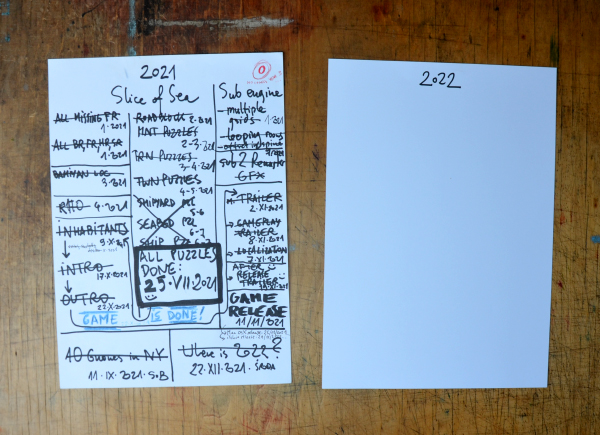
Plan A
Submachine: Legacy. The remaster of all Submachine games smashed together into one, giant Steam release. I need to write completely new engine for this. I also need to retouch some graphics that clearly need some love after a decade of remaining small-sized web games. I also need to export all of those graphics from flash, animate all moving things in Spine 4.0 or newer and finally create all logic from scratch in Game Maker Studio 2.37 or newer. Is this all doable in one year?… Let’s see.
Plan B
Submachine Card Game. Preparing a Kickstarter (or Indiegogo) campaign. Once funded – print them decks, send to backers and release the game worldwide. There are countless more steps to this entire thing, but these are biggest milestones. I also want to create loads of youtube videos going over rules and unclear situations that might occur during gameplay.
As you can see – I’m still in the process of getting to my preferable work cycle: having at most two projects at once. If possible – one.
In longer run – I want to settle on releasing one game and one comic book per year. If that proves too much – I’d switch to releasing games and comics bi-yearly (one year – a game, the other – a book).
But this is far in the future.
And this is now.
See you next year.
 Please introduce yourself.
Please introduce yourself.
My name is Mateusz Skutnik, I create games, mostly in the adventure puzzle point and click genre. I’m also a comic book writer and artist, and those two branches of my creativity just met in my newest game, Slice of Sea.
What is your most favorite PC/video game?
I think if I had to pick just one… It would be Journey by ThatGameCompany. This is the shining example why games can be real art.
Why did you start developing this game?
I was creating games for 15 years in Adobe Flash, and once they decided to end Flash support I moved to another game engine in 2016. This allowed me to create a game for Steam, which meant I had to pull all my strength and abilities together to create something unique for my Steam debut.
What is/are interesting/unique in the game?
This game in it’s entirety was drawn on paper using ink and nib. It took me 4 years to finish creating the game (2018-2021).
Uniqueness comes from my comic book drawing style, just take a look.
Whom would you like to play this game?
People who like adventure games and solving puzzles. This is a point and click game with a slight twist in that you use keyboard to move game’s main character and mouse to solve puzzles.
What kind of people is your target?
Anyone with a keen eye for unique graphical design, strange worlds and even stranger creatures. I know my games are played by people of all ages, from small children up to 70 year-olds.
Is the game inspired by any other games/movies/etc.?
The game is derived from all my previous works. My other game series – Submachine, Daymare Town, and my comic book series: Revolutions, Blacky, Morphs…
I just took everything good I created in the past and smashed it all together to create this game.
(If not yet) Do you have a plan to support the Japanese language? If you accept fan translation, who should we contact?
Japanese is already supported. You can change language in the main menu settings.
Has COVID-19 affected the development?
Not really, since I’ve been working at home since 2009. I also work alone, almost entire game, with the exception of music is done by me personally.
Is it okay to stream the game and monetize it? (on YouTube, Twitch, etc.)
Yes, of course!
Please leave a message for Japanese readers.
Hi guys. You can play my game in Japanese, and in my opinion Japanese version looks the best of all languages, mostly thanks to Kanji font used in the game, it matches the drawn and inked spirit of the game.
~~~~
ポイント&クリックパズルADV『Slice of Sea』―ペンとインクで描かれたグラフィックで4年の歳月をかけて完成【開発者インタビュー】
気になる新作インディーゲームの開発者にインタビューする本企画。今回は、Mateusz Skutnik氏開発、PC/Mac向けに11月11日にリリースされたポイント&クリックパズルアドベンチャー『Slice of Sea』開発者へのミニインタビューをお届けします。
本作は、プレイヤーが海の生き物「シーウィード」となってプレイするポイント&クリックパズルアドベンチャー。アイテムを集め、パズルを解き、シーウィードを故郷の海へと戻してあげるのが目標です。すべて手描きのグラフィックが特徴。日本語にも対応済みです。
――まずは自己紹介をお願いします。一番好きなゲームは何ですか?
Mateusz Skutnik氏(以下Mateusz)主にポイント&クリックパズルアドベンチャーといったゲームを作っている、Mateusz Skutnikです。私は漫画家でもありアーティストでもあります。これら2つのクリエイティビティが出会い誕生したのが、本作なのです。
もし好きなゲームを一本選ばなければいけないとすれば…thatgamecompanyの『風ノ旅ビト』ですね。ゲームが本物の芸術になり得るという、素晴らしい見本だと思います。
――本作の開発はなぜ始めたのですか?
Mateusz私はAdobe Flashを使って15年間ゲームを作っていました。そしてFlashのサポートが終わることが決定すると、2016年、私は別のゲームエンジンに移ることとしたのです。これにより、Steam向けのゲームが作れるようになりました。と言うことで、Steamでのデビューに向け、私は自分の持つあらゆる強みと能力を結集させることとしたのです。
――本作の特徴を教えてください。
Mateusz本作のグラフィックはすべて紙の上にペンとインクで描かれています。完成までに4年(2018年~2021年)かかりました。特徴は、私の漫画を描くスタイルそのものに出ているでしょう。ぜひその目でご覧ください。
――本作はどんな人にプレイしてもらいたいですか?
Mateuszアドベンチャーゲームとパズルを解くのが好きな人に遊んでもらいたいですね。本作はポイント&クリックゲームですが、キーボードを使ってメインキャラクターを操作し、マウスでパズルを解く、と言うひねりが加えられています。
また、ユニークなデザインや奇妙な世界観、そしてより変なクリーチャーたちに興味がある人にも遊んでいただきたいです。本作は、小さな子供から70年代の方まで、あらゆる歳の方たちに遊んでいただいています。
――本作が影響を受けた作品はありますか?
Mateusz本作は私の今までの作品すべてを起源としています。私の作ったゲームシリーズである『Submachine』『Daymare Town』、漫画シリーズだと「Revolutions」「Blacky」「Morphs」などですね。過去に作って良かった物を集めてくっつけ、本作を作ったのです。
――新型コロナウイルスによる開発への影響はありましたか?
Mateusz2009年から自宅で作業をしているので、影響はそれほどありませんでした。また、私は自分の作ったほぼすべてのゲームにおいて、音楽以外はすべて私1人で完成させています。
――本作の配信や収益化はしても大丈夫ですか?
Mateuszはい、もちろんです!
――最後に日本の読者にメッセージをお願いします。
Mateuszみなさん、こんにちは。本作は日本語でもプレイ可能です。私の個人的な意見になりますが、本作は日本語版が他のあらゆる言語よりも綺麗に見えると思っています。おそらく本作内で使われている漢字のフォントのおかげですね。本作のグラフィックにまさにぴったりなのです。楽しんでください!
――ありがとうございました。
[source]
Slice of Sea is a peaceful adventure and puzzle game. You play as Seaweed, a sea creature clearly out of their element. Explore desolate world of dust, all hand-drawn on paper in unique art style. Collect items, solve puzzles and lead Seaweed back home to the sea. Music was created by Thumpmonks and main theme song written and performed by Cat jahnke.
get it from my shop | get it on Steam | get it on itch.io | get it on GOG
get deluxe edition ThumpMonks soundtrack with bonus tracks
Major update and overhaul 2023 | reddit | homepage | title reveal
the mind spark that started it all… | Seaweed begins | pre-alpha timestamp
first ink sketch | atmospheric sketch | textured sketches | background sketches
p2019 | p2020 | p2021 | layering test | coloring test | ingame ink | bricks
Seaweed inside | Final Atmosphere | covid-19 quarantine | wywh
main trailer | gameplay trailer | release trailer | Let me go Home lyrics
reviews: Dasein Con Amore, adventuregamers.com, Kaftann, Jatsko,
TouTiao, Doredel, the Pixel Post, Buried Treasure, the Games Brew,
Sensu Stricte, Hey Poor Player, Polygamia, Indie Planet, PC Gamer,
Indie Game Reviewer, Indie Hive, Gaming Professors
interview: gamespark.jp
itch.io release: 29/11/2021 | GOG release init timestamp: 20/12/2024
post mortem: full devlog 2018-2021
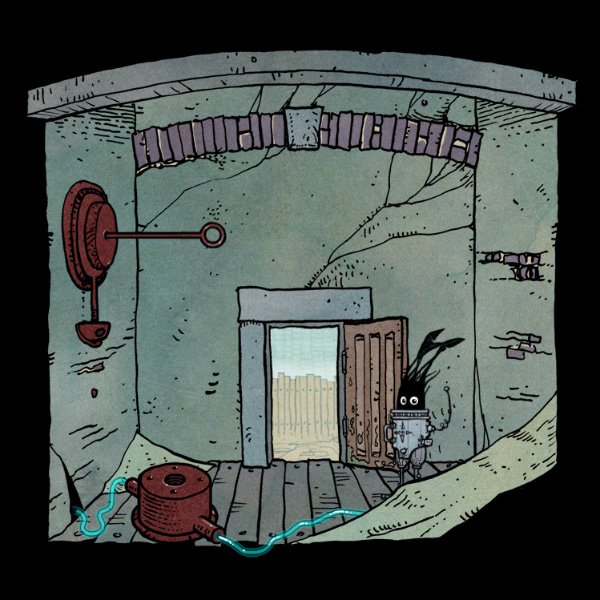
Yesterday I reached the most important milestone in Slice of Sea development, and I find it somewhat poetic. All puzzles are done and ready. That means entire gameplay is ready and the game is playable from start to finish. I’d say the game is 90% ready. Things still missing: intro, outro and some flavor graphics and non-interactable animations. I’m basically at the finish line, or the last lap to be exact. I can see the light at the end of a 4-year long tunnel. Time to get mildly hyped. #sliceofsea